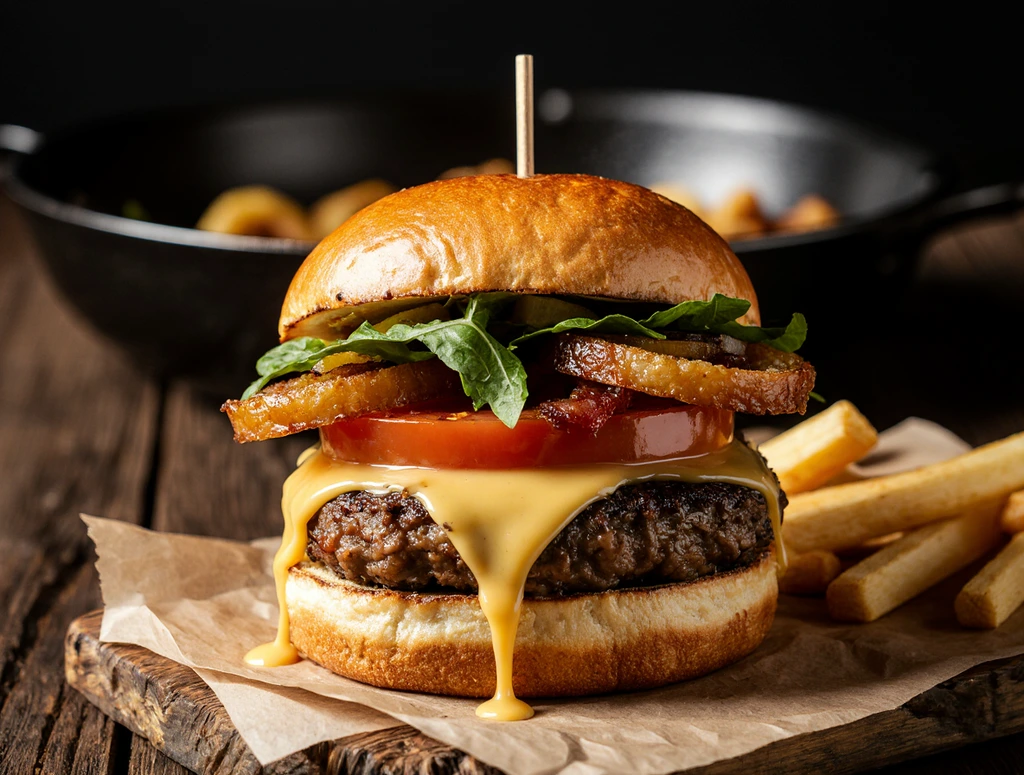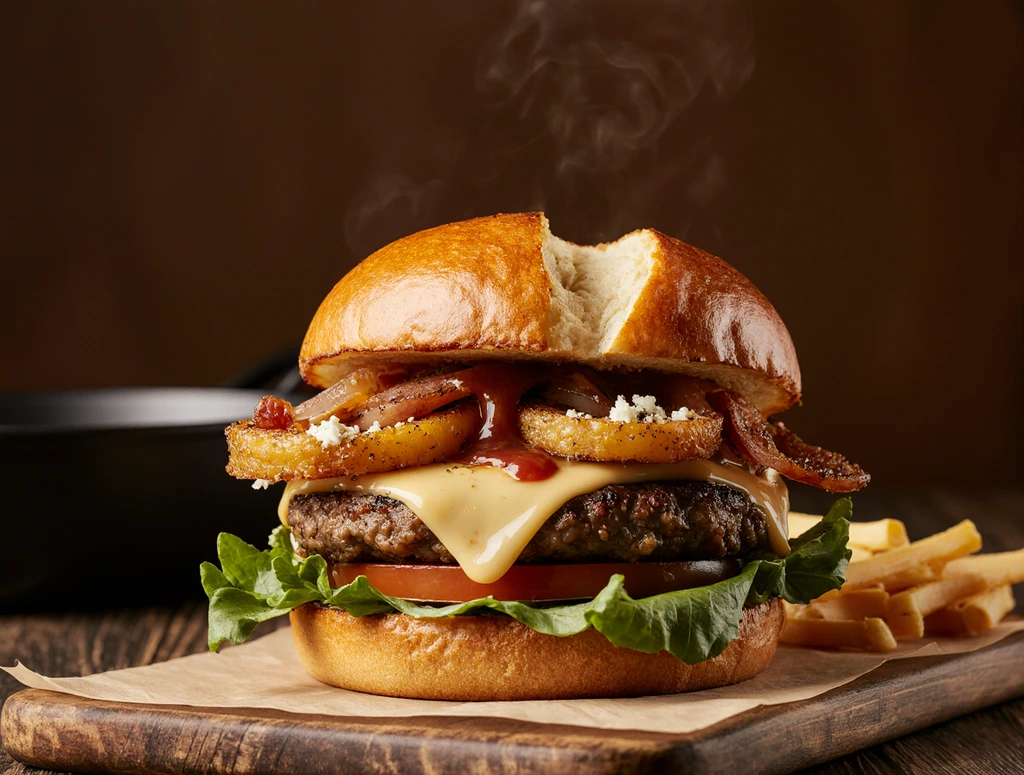
Master the Art of Cheeseburgers: Classic, Smash & Blue Cheese Perfection
Every great cheeseburger tells a story – the sizzle of beef hitting hot metal, the gentle melt of cheese cascading over perfectly seasoned meat, and that satisfying first bite that brings all the flavors together. As someone who’s spent three decades behind professional stoves and grills, I’ve learned that creating exceptional cheeseburgers at home isn’t just about following recipes; it’s about understanding the science, respecting the ingredients, and mastering fundamental techniques.
Today, I’m sharing my most treasured burger wisdom with you. We’ll explore three legendary styles: the iconic all-American classic, the trendy smash burger with its signature crispy edges, and an elegant blue cheese creation that transforms humble ground beef into gourmet artistry. Each style demands its own approach, but all share the same foundation of quality and technique.
This comprehensive guide will transform your burger game forever, teaching you not just what to do, but why each step matters and how small adjustments create dramatically different results.
Complete Guide Overview
- Exploring Iconic Cheeseburger Styles
- Essential Tools and Premium Ingredients
- Mastering the Classic American Cheeseburger
- How to Make Smash Burgers Like a Pro
- Elevated Blue Cheese Burger Creation
- Grilling Mastery for Perfect Results
- Air Fryer Cheeseburger Innovation
- West Coast California Style
- Smoky BBQ Bacon Cheeseburger Excellence
- Cheese Selection Mastery
- Bread Foundation Excellence
- Expert-Level Cooking Secrets
- Problem-Solving Common Issues
- Health-Conscious Adaptations
Exploring Iconic Cheeseburger Styles

Traditional American Classic
The backbone of American burger culture rests in simplicity executed flawlessly. A substantial patty – typically ranging from quarter-pound to half-pound – delivers pure beef flavor enhanced by perfectly melted cheese and carefully selected accompaniments. This style prioritizes ingredient quality over complexity, creating that nostalgic diner experience that defines comfort food excellence.
Revolutionary Smash Technique
The smash burger revolution has transformed modern burger culture by maximizing flavor through scientific precision. Ultra-thin patties pressed onto blazing hot surfaces create extensive browning through the Maillard reaction, generating crispy, lace-like edges packed with concentrated umami flavors. This technique proves that thickness doesn’t determine taste – proper execution does.
Sophisticated Blue Cheese Artistry
Elevating burgers into gourmet territory, blue cheese burgers combine bold, complex flavors that challenge and delight adventurous palates. The pungent, creamy blue cheese creates fascinating flavor contrasts against rich beef, while supporting ingredients like caramelized onions and fresh greens add textural variety and flavor balance.
Essential Tools and Premium Ingredients
Superior Beef Selection
Outstanding cheeseburgers begin with exceptional ground beef. My preferred ratio remains 80% lean to 20% fat – this proportion delivers optimal juiciness without excessive grease. For premium applications, consider custom grinding combinations: chuck roast provides flavor foundation (70%), sirloin adds structure (20%), and short rib contributes richness (10%).
Chef’s Insight: Fresh grinding produces superior texture compared to pre-packaged options. Request custom grinding from your butcher for remarkable results.
Professional Equipment Essentials
- Heavy-bottomed cast iron skillet or commercial griddle
- Wide, flexible burger spatula with beveled edge
- Digital instant-read thermometer for precision
- Kitchen scale ensuring consistent portioning
Quality Ingredient Foundation
- Premium ground beef (80/20 ratio preferred)
- Kosher salt and coarse-ground black pepper
- American cheese (classic applications), aged cheeses (gourmet styles)
- Artisan brioche or potato buns
- European-style butter for toasting
- Premium condiments and fresh vegetables
Mastering the Classic American Cheeseburger
Recipe Components (4 Servings)
- 1.5 pounds fresh ground beef (80/20 blend)
- 4 slices premium American cheese
- 4 fresh brioche buns
- 3 tablespoons unsalted butter
- Kosher salt and fresh black pepper
- Crisp lettuce leaves, ripe tomatoes, sweet onion
- Quality mayo, ketchup, and mustard
Step-by-Step Mastery
Foundation Preparation Portion beef into four equal 6-ounce portions using a kitchen scale. Shape gently into patties slightly exceeding bun diameter – cooking shrinkage requires this compensation. Press a shallow depression into each patty’s center, preventing excessive puffing during cooking. Reserve seasoning until immediately before cooking to prevent moisture extraction.
Heat Management Preheat your cast iron skillet over medium-high flame for exactly 5 minutes. Proper temperature creates immediate searing – test with water droplets that should dance and evaporate instantly.
Cooking Excellence Season patties generously just before cooking. Place in hot skillet without crowding, avoiding the temptation to press or move them. Initial searing requires 3-4 minutes for proper crust development. Flip once when golden crust releases naturally, immediately adding cheese. Continue cooking 3-4 minutes for medium doneness.
Bun Preparation Toast bun halves in butter until golden and aromatic. This crucial step prevents sogginess while adding rich flavor complexity.
Assembly Architecture Layer thoughtfully: condiments on bottom bun, followed by lettuce, cheese-topped patty, tomato, onion, and crowned with top bun.
This methodical approach creates the quintessential perfect cheeseburger that embodies American culinary tradition. For additional classic inspiration, explore our classic cheeseburger with melted cheese drip techniques.
How to Make Smash Burgers Like a Pro
Smash burgers represent culinary innovation through simplicity – maximum flavor achieved through precise technique rather than ingredient complexity.
Understanding the Science
Pressing thin patties onto extremely hot surfaces maximizes surface contact area, accelerating the Maillard reaction that creates those signature crispy, flavorful edges. This browning reaction develops more concentrated flavors in thin patties than traditional thick versions achieve.
Professional Smash Technique
Ingredients (4 Servings)
- 1 pound ground beef (80/20, loosely handled)
- 8 slices American cheese
- 4 potato burger buns
- Butter for toasting
- Kosher salt and black pepper
- Dill pickles and thinly sliced onions
Execution Method:
- Form loose beef balls (2 ounces each, creating 8 portions)
- Heat cast iron skillet until smoking vigorously
- Place beef ball on surface, immediately smashing completely flat with wide spatula
- Season aggressively with salt and pepper
- Cook undisturbed for 90 seconds, flip, add cheese, cook additional 60 seconds
- Create double-stack burgers using two patties per serving
Critical Success Factor: Never disturb patties during initial cooking – those crispy edges are culinary gold!
Double-Stack Construction
Smash burger magic happens in the layering: bottom bun, sauce, pickles, first cheese-topped patty, second cheese-topped patty, onions, top bun. This architecture creates optimal flavor distribution and textural contrast.
Elevated Blue Cheese Burger Creation
This blue cheese burger recipe transforms ordinary beef into restaurant-caliber sophistication through careful ingredient selection and technique refinement.
Gourmet Ingredient List
- 1.5 pounds premium ground beef blend
- 4 ounces artisanal blue cheese (Maytag Blue or Roquefort preferred)
- 4 brioche buns
- 2 large Vidalia onions for caramelization
- 4 strips applewood-smoked thick-cut bacon
- Fresh arugula for peppery contrast
- House-made garlic aioli
Blue Cheese Preparation Technique
Create blue cheese compound by gently mashing premium blue cheese with heavy cream and minced fresh garlic. This preparation maintains cheese integrity while ensuring even distribution and preventing complete melting during cooking.
Caramelized Onion Mastery
Slice sweet onions uniformly and cook slowly in butter over low heat for 45-60 minutes until deeply caramelized and golden. This patience creates natural sweetness that perfectly balances blue cheese’s bold character.
Assembly and Execution
Form thicker 6-ounce patties for this sophisticated preparation. Cook to medium-rare (130°F internal) to maintain optimal juiciness. The harmony between creamy blue cheese, sweet onions, and peppery arugula creates complex flavor layering that defines gourmet burger artistry.
Discover more sophisticated approaches in our Italian cheeseburger collection.
Grilling Mastery for Perfect Results
Outdoor grilling introduces smoky complexity impossible to replicate indoors, but success depends on understanding heat management and timing precision.
Grill Configuration and Heat Control
Dual-Zone Setup: Configure your grill with direct high heat (450-500°F) for initial searing and indirect moderate heat (350°F) for gentle finishing. This arrangement provides cooking flexibility and prevents burning.
Temperature Monitoring:
- Searing zone: 450-500°F for crust development
- Finishing zone: 350°F for even cooking
- Internal targets: 135°F (medium-rare) through 160°F (well-done)
Advanced Grilling Technique
- Grate Preparation: Oil grates thoroughly using paper towels to prevent sticking
- Patience in Flipping: Allow natural release (3-4 minutes) before attempting to flip
- Cheese Integration: Add cheese during final cooking minute for optimal melting
- Resting Protocol: Rest finished burgers 2-3 minutes for juice redistribution
Common Grilling Pitfalls
Resist pressing patties with your spatula – this expels valuable juices. Similarly, avoid excessive movement; trust the grill’s heat to work properly.
Air Fryer Cheeseburger Innovation
Modern air fryers excel at burger preparation by providing consistent heat circulation and superior results with minimal oil usage.
Air Fryer Methodology
Optimal Settings:
- Preheat temperature: 370°F
- Initial cooking: 6 minutes
- Post-flip cooking: 4-6 minutes additional
- Cheese addition: Final 2 minutes
- Bun toasting: 1-2 minutes separately
Air Fryer Benefits
- Uniform cooking without temperature variations
- Significantly reduced oil requirements
- Predictable, repeatable results
- Simplified cleanup process
Recipe Adaptation Guidelines
Reduce traditional cooking times slightly due to efficient air circulation. Always verify internal temperatures for food safety compliance.
West Coast California Style
The California cheeseburger philosophy celebrates fresh, healthful ingredients that complement rather than overpower beef’s natural character.
Signature California Components
- Perfectly ripe avocado slices
- Fresh sprouts or mixed baby greens
- Peak-season tomatoes
- Mild red onion
- Thousand Island or house-made special sauce
Preparation Excellence
Select avocados at perfect ripeness – yielding slightly to pressure without mushiness. Slice immediately before assembly to prevent oxidation browning.
Regional Interpretations
California style varies by region:
- Northern California: Emphasizes organic, locally-sourced ingredients
- Southern California: Often incorporates jalapeños for mild heat
- Coastal California: Sometimes features seafood additions like crab or shrimp
Smoky BBQ Bacon Cheeseburger Excellence
The BBQ bacon cheeseburger represents American flavor fusion at its finest – combining barbecue, bacon, and cheese into harmonious perfection.
Flavor Layer Development
Bacon Excellence: Select thick-cut, premium bacon. Cook until crispy yet retaining some chew – complete brittleness creates textural problems.
BBQ Sauce Strategy: Apply barbecue sauce strategically:
- Brush onto patties during final cooking moments
- Add additional sauce during final assembly
Regional BBQ Sauce Styles
- Kansas City: Thick, molasses-sweetened, rich
- Carolina: Vinegar-forward, tangy, bright
- Texas: Tomato-based with chili heat
Optimal Assembly Sequence
Build methodically: bottom bun, sauce base, lettuce, patty, cheese, bacon, optional onion rings, additional sauce, top bun.
Cheese Selection Mastery
Cheese selection profoundly influences final flavor profiles and melting characteristics – understanding options enables better decision-making.
Traditional Cheese Varieties
American Cheese
- Melts uniformly and predictably
- Mild flavor supports beef without competition
- Classic choice for traditional perfect cheeseburgers
Aged Cheddar
- Sharp varieties provide flavor complexity
- Longer aging develops deeper taste profiles
- Superior melting when properly applied
Swiss Cheese
- Nutty, subtle flavor character
- Classic pairing with sautéed mushrooms
- Distinctive appearance adds visual interest
Premium Cheese Options
Artisanal Blue Cheese
- Bold, complex flavor profile
- Appeals to sophisticated palates
- Excellent with caramelized onions
Gruyère
- Sophisticated, nutty character
- Exceptional melting properties
- European elegance in American comfort food
Optimal Melting Methods
Add cheese during cooking’s final minute and cover with dome or lid to trap heat for complete melting.
Bread Foundation Excellence
Buns provide structural foundation and significant flavor contribution – proper selection and preparation prove essential.
Premium Bun Varieties
Brioche Buns
- Rich, buttery flavor complexity
- Soft texture with structural integrity
- Ideal for gourmet applications
Potato Buns
- Subtle sweetness and excellent moisture retention
- Classic American burger choice
- Superior holding power
Sesame Seed Buns
- Traditional appearance and nutty sesame flavor
- Widely available and economical
- Nostalgic American diner aesthetic
Professional Bun Preparation
Always toast buns! This fundamental step:
- Prevents soggy bottoms
- Creates textural contrast
- Enhances flavor through browning reactions
Toasting Technique: Apply light butter coating to cut surfaces and toast in dry skillet until golden brown and aromatic, approximately 2-3 minutes.
Expert-Level Cooking Secrets
Three decades of professional cooking have taught me techniques that separate exceptional burgers from merely good ones:
Precision Temperature Control
Internal Temperature Targets:
- Rare: 120-125°F (cool red center)
- Medium-rare: 130-135°F (warm red center)
- Medium: 140-145°F (warm pink center)
- Medium-well: 150-155°F (slightly pink center)
- Well-done: 160°F+ (no pink remaining)
Seasoning Mastery
- Salt patties immediately before cooking to prevent moisture extraction
- Use coarse kosher salt for superior adherence
- Freshly crack black pepper for maximum potency
- Consider garlic powder for additional depth
Resting Importance
Rest cooked burgers 2-3 minutes before serving. This allows juice redistribution, preventing loss during first bite.
Preparation Organization
Prepare all accompaniments before cooking begins. Burgers cook rapidly, requiring immediate assembly capability.
Problem-Solving Common Issues
Dry Burger Solutions
Root Causes: Overcooking, excessive leanness, over-manipulation Solutions: Use proper fat ratio, minimize handling, monitor internal temperature
Structural Integrity Problems
Root Causes: Over-mixing, insufficient fat content, inadequate binding Solutions: Handle gently, maintain fat content, add breadcrumb binder if necessary
Uneven Cooking Issues
Root Causes: Inconsistent thickness, temperature variations Solutions: Use consistent portioning, maintain steady heat
Cheese Melting Problems
Root Causes: Premature addition, insufficient heat retention Solutions: Add during final minute, cover for heat trapping
For comprehensive troubleshooting, reference our homemade cheeseburger problem-solving guide.
Health-Conscious Adaptations
Understanding nutritional implications enables informed choices without sacrificing flavor enjoyment.
Standard Nutritional Profile (6-ounce patty)
- Calories: 750-900
- Protein: 35-45 grams
- Fat: 45-60 grams
- Carbohydrates: 35-45 grams
Healthier Modifications
Leaner Protein Options:
- 90/10 ground beef (requires moisture enhancement techniques)
- Ground turkey or chicken blends
- Plant-based protein alternatives
Reduced-Fat Cheese Strategies:
- Lower-fat cheese varieties
- Smaller portions of full-fat options
- Nutritional yeast for umami enhancement
For healthier alternatives, explore our comprehensive turkey burger guide.
Advanced Culinary Techniques
Stuffed Burger Innovation
Create cheese-filled patties by wrapping thin meat layers around cheese cores. This technique produces molten cheese centers that create dramatic presentation and intense flavor bursts.
Reverse Searing Method
For thick patties, begin in low oven (275°F) until nearly finished, then complete with high-heat searing for perfect edge-to-edge doneness.
Compound Butter Integration
Blend herbs, roasted garlic, or blue cheese into softened butter, then place on hot burgers for luxurious melting richness.
Storage and Make-Ahead Strategies
Raw Patty Storage
- Refrigerate maximum 2 days
- Freeze up to 3 months with proper wrapping
- Separate layers with parchment paper
Cooked Burger Storage
- Refrigerate 3-4 days maximum
- Reheat gently in skillet over medium heat
- Add moisture with small amounts of beef broth
Preparation Planning
- Pre-form and freeze patties for convenience
- Prepare accompaniments in advance
- Make compound butters ahead of time
Key Success Principles
- 80/20 ground beef ratio provides optimal flavor and juiciness balance
- Minimal meat handling prevents tough, dense texture
- Center dimpling in thick patties prevents excessive puffing
- Salt immediately before cooking maintains moisture content
- Always toast buns for superior texture and flavor
- Rest finished burgers allows juice redistribution
- High heat for smashing maximizes crust development and flavor
Final Thoughts
Mastering cheeseburger creation combines scientific understanding with culinary artistry. Whether crafting timeless American classics, experimenting with innovative smash techniques, or creating sophisticated blue cheese masterpieces, success depends on quality ingredients, proper technique, and careful attention to detail.
Cheeseburgers embody culinary democracy – accessible to everyone yet capable of sophisticated expression. From casual weeknight dinners to impressive entertaining, there’s always an appropriate style and technique. Remember that mastery develops through practice – each burger teaches valuable lessons about heat control, timing, and flavor development.
Embrace experimentation with different cheese varieties, creative toppings, and alternative cooking methods. These foundational techniques provide your starting point, but personal preferences should guide your culinary evolution. Whether you prefer classic simplicity or gourmet complexity, the satisfaction of creating exceptional food with your own hands remains unmatched.
Time to heat up that skillet or fire up the grill! Choose one of these proven techniques and begin your burger mastery journey today. Share your results and experiences – the cooking community thrives on shared knowledge and mutual inspiration.
For continued inspiration, explore our extensive collection of Italian burger recipes or discover our beloved sliders techniques.
Expert Q&A Section
Q: What fat percentage works best for cheeseburger meat? A: The 80/20 ratio (80% lean, 20% fat) delivers optimal flavor and juiciness balance. Leaner ratios often produce dry results, while higher fat content can create greasy burgers.
Q: How long should cheeseburgers cook? A: Quarter-pound patties typically require 3-4 minutes per side over medium-high heat for medium doneness. Always verify with thermometer readings – 135°F for medium-rare, 160°F for well-done safety.
Q: Can cheeseburger patties be prepared in advance? A: Raw patties can be formed up to 2 days ahead and refrigerated, or frozen for up to 3 months. Cooked burgers maintain quality for 3-4 days under refrigeration.
Q: How can I prevent burger shrinkage during cooking? A: Create shallow depressions in patty centers before cooking. This prevents excessive puffing and maintains consistent size throughout the cooking process.
Q: What makes restaurant cheeseburgers taste superior to homemade versions? A: Restaurants typically use higher-fat beef, cook on extremely hot flat-top surfaces, employ specific seasoning blends, minimize meat handling, and properly toast their buns.
About Chef Khalid: Drawing from over 30 years of professional culinary experience and an unwavering passion for burger perfection, Khalid shares his expertise through TheFoodNearMe. His philosophy combines time-tested traditional methods with innovative modern techniques, empowering home cooks to achieve professional-quality results.
Which cheeseburger style excites you most? Share your burger adventures and tag us on social media – we celebrate every culinary success! Subscribe for ongoing gourmet recipes and professional cooking insights.
Authoritative References
- Food Network – Professional Burger Cooking Methods
- Journal of Food Science – Maillard Reaction in Ground Meat Applications
- USDA Food Safety Guidelines – Ground Beef Temperature Requirements
- Serious Eats – Scientific Approach to Smash Burger Development
- America’s Test Kitchen – Comprehensive Burger Testing Methodology
